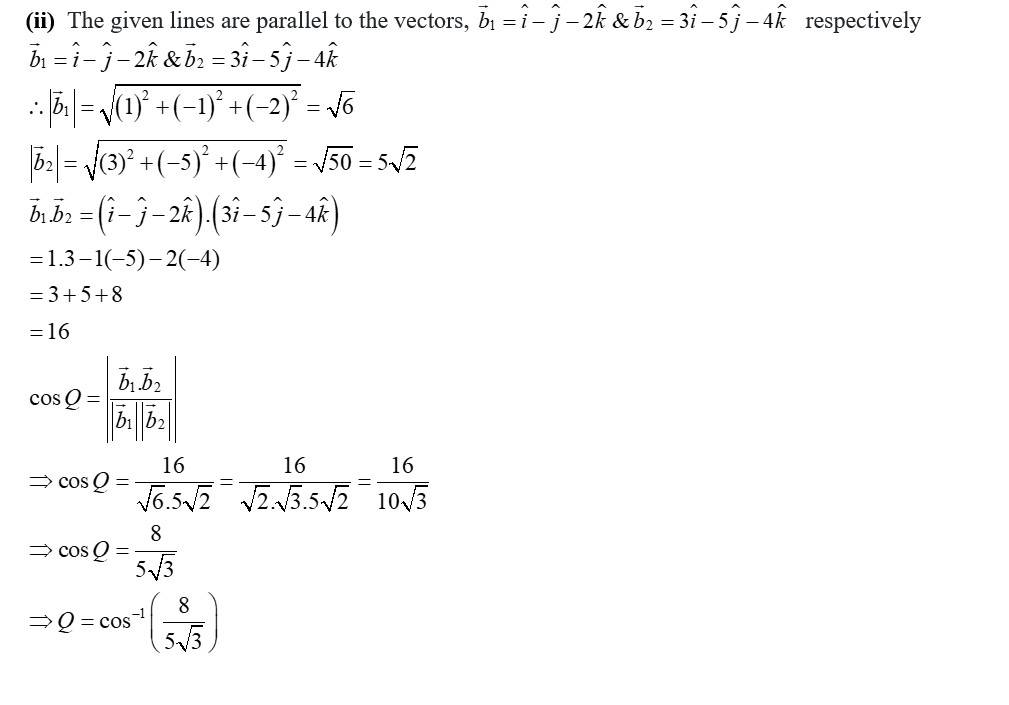Ncert Solutions Maths class 12th
Get insights from 2.5k questions on Ncert Solutions Maths class 12th, answered by students, alumni, and experts. You may also ask and answer any question you like about Ncert Solutions Maths class 12th
Follow Ask QuestionQuestions
Discussions
Active Users
Followers
New answer posted
4 months agoContributor-Level 10
32. Given, f (x) = sin
Let g (x) = sin x and h (x) = then as sine f x and modulus f x are continuous in x e R
g and h are continuous.
So, (goh) (x) = g (h (x) = g (|x|) = sin |x| = f (x)
Is a continuous f x being a competitive f x of two continuous f x.
New answer posted
4 months agoContributor-Level 10
(i) Let Q be the angle between the given lines.
The angle between the given pairs of lines is given by,
The given lines are parallel to the vectors, , respectively.

New answer posted
4 months agoContributor-Level 10
31. Given, f (x) =
Let g (x) = cos x and h (x) =
Hence, as cosine function and modulus f x are continuous h are continuous.
Then, (hog) x = h (g (x)
= h (cos x)
= f (x) is also continuous being
A composites fxn of two continuous f x
New answer posted
4 months agoContributor-Level 10
Let the line passing through the points, P (3, −2, −5) and Q (3, −2, 6), be PQ.
Since PQ passes through P (3, −2, −5), its position vector is given by,
The direction ratios of PQ are given by,
The equation of the vector in the direction of PQ is
The equation of PQ in vector form is given by,
The equation of PQ in Cartesian form is
i.e,
New answer posted
4 months agoContributor-Level 10
The required line passes through the origin. Therefore, its position vector is given by,
The direction ratios of the line through origin and are
The line is parallel to the vector given by the equation,
The equation of the line in vector form through a point with position vector and parallel to is,
The equation of the line through the point and direction ratios is given by,
Therefore, the equation of the required line in the Cartesian form is
New answer posted
4 months agoContributor-Level 10
30. Given f (x) = cos (x2)
Let g (x) = cos x is a lregononuie fa (cosine) which is continuous function
and let h (x) = x2 is a polynomial f xn which is also continuous
Hence (goh) x = g (h (x)
= g (x)2
= cos (x2)
= f (x)
is also a continuous f x being a composite fxn of how continuous f x
New answer posted
4 months agoContributor-Level 10
Given,
Cartesian equation,
The given line passes through the point
i.e. position vector of
Direction ratio are 3, 7 and 2.
Thus, the required line passes through the point and is parallel to the vector .
Let be the position vector of any point on the line, then the vector equation of the line is given by,
New answer posted
4 months agoContributor-Level 10
Given,
The point .
The Cartesian equation of a line through a point and having direction ratios a, b, c is
Now, given that
is parallel
to point
Here, the point is and the direction ratio is given by
The required Cartesian equation is
New answer posted
4 months agoContributor-Level 10
29. Given, f(x) =
For continuity at x = 2,
5 = 2a + b (i)
For continuous at x = 10,
10a + b = 21 (2).
So, e q (2) 5 e q (1) we get,
10a + b 5 (2a + b) = 21 5 5.
10a + b 10a 5b = 21 25.
4b = 4
b = 1.
And putting b = 1 in e q (1),
2a = 5 b = 5 1 = 4
Hence, a = 2 and b = 1.
New answer posted
4 months agoContributor-Level 10
The line passes through the point with position vector,
The given vector:
The line which passes through a point with position vector and parallel to is given by,
This is required equation of the line in vector form.
Now,
Let
Comparing the coefficient to eliminate ,
Taking an Exam? Selecting a College?
Get authentic answers from experts, students and alumni that you won't find anywhere else
Sign Up on ShikshaOn Shiksha, get access to
- 65k Colleges
- 1.2k Exams
- 687k Reviews
- 1800k Answers

